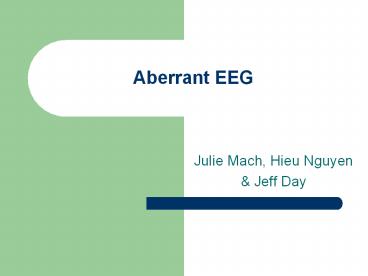Aberrant EEG - PowerPoint PPT Presentation
1 / 30
Title:
Aberrant EEG
Description:
Aberrant EEG Julie Mach, Hieu Nguyen & Jeff Day EEG Biofeedback Electroencephalogram monitors brain activity Patients learn to control certain functions Successful ... – PowerPoint PPT presentation
Number of Views:203
Avg rating:3.0/5.0
Title: Aberrant EEG
1
Aberrant EEG
- Julie Mach, Hieu Nguyen
- Jeff Day
2
EEG Biofeedback
- Electroencephalogram monitors brain activity
- Patients learn to control certain functions
- Successful Applications
- ADHD
- Anxiety disorders
- Mood disorders
- Seizure disorders
- Traumatic brain injury
- Addiction
3
Aberrant EEG
- Non-invasive procedure
- Direct measure of cortical activity
- May detect brain abnormalities before behavioral
symptoms appear - Can monitor changes as diseases progress
4
Traumatic Brain Injury
- Symptoms
- Initial loss of consciousness
- Impaired memory, attention concentration
- Personality changes
- Treatment
- No signature EEG pattern
- Determine affected cortical regions using QEEG
- 60 of patients improved after 40 biofeedback
sessions
5
Brain Stem Potentials
- Subcortical function measured using auditory
stimuli - 10 auditory clicks per second
- Independent of attention level (coma)
- Locate midbrain and brainstem tumors
- Wave I 8th cranial nerve activity
- Wave II 8th cranial nerve lower pons
- Wave III pons
- Waves IV V inferior colliculus
- Waves VI VII neurons from thalamus to
auditory cortex
6
(No Transcript)
7
Coma Brain Death
- Isoelectric or flatline EEG
- EEG lt 2µV in amplitude
- Indicates brain death after 2 exams in 24 hours
- Coma patients
- May show ERP responses to visual and
somatosensory stimulation - Some regain spontaneous cortical activity
8
Multiple Sclerosis
- Degeneration of myelin covering on axons
- Abnormal visual ERPs
- P100 delayed, deviant waveform
- Abnormal brain stem potentials
- Abnormal somatosensory ERPs (delayed)
- Increased sensitivity for diagnosis
- ERP 90.5
- MRI 71.4
9
CNS Degenerative Disease
- Spinal cord ERPs
- Conduction velocity delayed
- Cerebral ERPs may be absent
- Delayed visual ERPs
- Detect lesions on optic nerve
- Monitor compression of optic nerve by tumors
- Determine effects after surgery
10
Huntingtons Chorea
- Inherited subcortical dementia (midbrain)
- Delayed sensory ERPs
- N1 and P2
- Delayed cognitive ERPs
- N2 and P300
- Visual ERPs
- Reduced amplitude in P100
11
Parkinsons Disease
- Motor disorder
- Dopamine deficiency in basal ganglia
- Auditory ERPs
- Decreased amplitude of N1 and P3
- Prolonged N2 latency during sensorimotor task
12
Alzheimers Disease
- Loss of cognitive functions (esp. memory)
- Auditory ERPs
- Prolonged P300 latency
- Decreased amplitude of P300
- Distributed differently among brain locations
13
Human Immunodeficiency Virus
- Neurological complications may occur in 32-87 of
patients - Encephalitis
- Dementia
- Tumors
- Decreased P300 amplitude
- Delayed P2 and P300 responses
14
EEG Biofeedback Epilepsy
15
What is Epilepsy?
- brain disorder, aka seizure disorder
- 4 million epileptics in the U.S. (The Epilepsy
Foundation) - During epilepsy - neurons in the cerebral
hemispheres misfire and create abnormal
electrical activity. - People with epilepsy have seizures that prevent
the brain from - interpreting and processing incoming sensory
signals - controlling muscles.
- Many types
- - petit mal epilepsy
- - grand mal epilepsy,
- - psychomotor epilepsy
16
EEG in Epilepsy
- Epilepsy produces abnormal EEG patterns
- Epileptic activity take many forms generalized
or focal - Spike activity is often seen.
- In petit mal epilepsy waves of 3 per second
spike are common - Psychomotor epilepsy often show spike complexes
that occur over the affected lobe.
17
Normal EEG
18
Generalized epilepsy EEG
19
Benign focal epilepsy EEG
20
Use of EEG
- Help identify the location, severity, and type of
seizure disorder. - Drawback interpretation of borderline records
due to these types of records show up in about
20 of the normal population (Simpson Magee,
1973) - Give positive or negative results
21
EEG Biofeedback and Epilepsy Applications
- Treatment have focused on influencing EEG pattern
through BFT. - Use of EEG/BFT started with Sterman and
colleagues (increase in 12- to 16- Hz EEG in
cats) - Reduction in seizure frequency when biofeedback
was used to train the production of 12- to 14- Hz
EEG from over the Rolandic(central) cortex
(Sterman and colleagues, 1974). - EEG/BFT with epileptics is time-consuming and
costly, although benefits are great
22
Brain-Computer Interface (BCI)
- Thought Translation Device
- Mu based BCI
- Implanted
- Case Study Matt Nagle
23
Thought Translation Device
- Niels Birbaumer Tuebengin University
- Provides Locked in ALS patients with a basic
communications capabilities - Patients learn to control slow cortical
potentials (SCPs), a wave type that a wave-type
with among the lowest frequencies (0.1-0.5 Hz)
that can be detected by an EEG.
24
SCP
- Patients learn to produce SCP shifts in positive
and negative directions. - Positive reinforcement used in the learning
process. - EEG ? Computer ? Cursor Movement on a screen.
- Stages
- Goal
- Language Support Program
- Takes time!
25
How it works
26
EEG and fMRI
27
Mu Based
- Same principles of SCP based, now using Mu
readings. - Can be used (after training) by those with
paralysis to control an orthesis by using thought
and imagination.
28
Neuromotor Prosthetic Device
- Monkey Studies
- Dawn Taylor
- Johan Wessberg
- Matt Nagle
29
Matt Nagle Robo-Sapien
30
References
- Andreassi, J. L. (2000) Human Behavior
Physiological Response (4th ed). Lawrence
Erlbaum Associates Mahwah, New Jersey. - Brain Tuning, http//www.brain-tuning.de/2ndlevel/
applic/impla2_2_b.htm - Donahue Lab, http//donoghue.neuro.brown.edu/
- Guardian, http//www.guardian.co.uk/life/feature/s
tory/0,13026,1448140,00.html - Nature, http//www.niu.edu/user/tj0dgw1/pdf/tetrap
legia2006.pdfsearch22doi3A10.10382Fnature0497
022 - Schwartz, M.S. Andrasik, F. (2003). Biofeedback
A Practitioners Guide (3rd ed). Guilford
Press New York, NY - U. Tuebingen, http//www.uni-tuebingen.de/uni/tci/
projekte/als.htm

